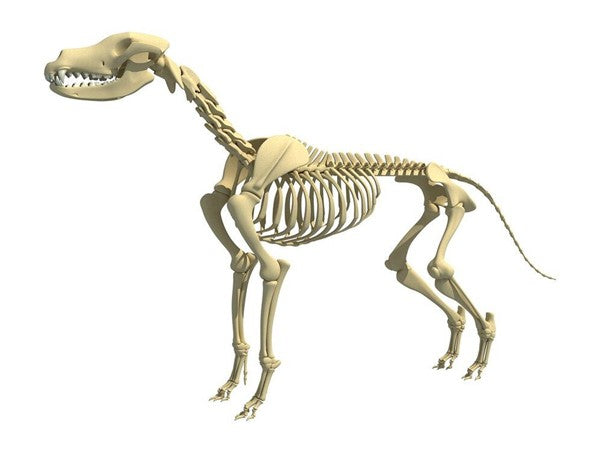
How to Prevent Rickets in Puppies
I can say without any doubt that dogs are one of the cutest creatures in this world. Okay, okay, I was hoping you wouldn’t hold it against me. Of course, all animals are cute in their own way, but I’m going to write a bit biased here.
When a puppy arrives in the family, you can certainly count on three things:
- Immeasurable happiness
- Cleaning “accidents”
- Changes in the current way of life
So it aggravates me to know that puppies need to be taken care of because of the high probability of rickets. It ticks my nerves when something that small and cute has a great chance of getting a bone disorder.
Before people get into drama mode, they should know that everything is in the way of diet.
Wrong food causes rickets in puppies
Rickets is a disease of the bones of puppies and young dogs. It occurs during the growth of the cub’s bones as a result of disturbances in the metabolism of calcium, phosphorus, and microelements.
It occurs due to insufficient representation of these substances in the food or as a result of an unbalanced meal for the puppy. For example, vitamin D is essential for depositing mineral substances in the development of the bone system.
Rickets is widespread in puppies, and almost no puppy is not predisposed to this disease. The needs of bitches for nutrients and minerals during pregnancy are increased, and puppies grow very intensively after birth. That requires a large number of nutrients and minerals in their diet.
All in all, a disease can be cured, but if you properly feed and care for your dog, it will not even appear.
Increased caution for owners of larger breeds.
Owners of puppies often, for fear of the appearance of this or some other disease, exaggerate the number of vitamins in the food. Or maybe they insist on frequent vitamin injections, which is not correct because an overdose of vitamins A and D causes too rapid completion of ossification with numerous issues (lower growth and bone deformations).
How do puppies get rickets?
Bone tissue has a role in supporting the body. For example, the muscles that move the body are attached to it. Therefore, all ingredients found in food (proteins, fats, carbohydrates, vitamins, minerals, etc.) are necessary for the development of bones.
All of them directly or indirectly affect the growth of the bone system.
The problem of crooked legs that occurs in puppies during the growth period can be a consequence of improper or deficient nutrition. For this reason, I advise you to feed your dog ready-made dehydrated food of super-premium quality. They are optimally balanced, meaning all nutrients are represented in the correct proportions and quantities.
The most common nutritional errors that lead to bone changes are too little or too much intake of minerals (calcium, phosphorus, omega) and vitamin D.
Vitamin D is responsible for the resorption of calcium and phosphorus from the intestines and for the optimal activity of osteoblasts and osteoclasts (cells that affect growth and bone formation).
In addition to these three components, the ratio of calcium and phosphorus must be correct: 2:1. Then, the organism makes the best use of all these minerals to mineralize the skeleton.
I advise you to add some food supplements containing calcium, phosphorus, vitamin A, vitamin D3, GAG component -glycosaminoglycans, omega 3 fatty acids, and chondroitin sulfate to the dog which already has the problem of crooked legs.

RICKETS IN PUPPIES (SYMPTOMS)
Typical signs of rickets that the owner will notice are:
Enlarged leg joints,
Sluggish movement,
A stiff gait or a limp, and
Lumps on the ribs at the junction of the bony and cartilaginous parts of the rib
The disease is chronic, so if it lasts longer, it leads to deformation of the long tubular bones of the extremities, disturbances in the change of teeth, and even deformation of the bones of the skull, especially the upper jaw.
The best food for small breed puppies
It is a big misconception to think that feeding and maintenance are more accessible than with larger dog breeds due to the size of the small species. Moreover, small breeds are very demanding, (especially the breeds that we popularly call “toys”), because of the risk for developing hypoglycemia.
Hypoglycemia is a condition that indicates a reduced amount of sugar in the blood. Puppies of small breeds are prone to developing this condition due to their accelerated metabolism and low reserves of sugar and fat in the body.
This means you must strictly ensure that the food is high in calories, whatever type of food you choose for small breed puppies. And at first, meals should be given 4 to 6 times a day.
The best food for large breed puppies
Large breed puppies also require attention when it comes to their meal. In addition, these puppies grow much faster than small breed puppies. For example, a puppy of a large breed that was born weighing 1 kg in 18 months can reach its total weight, which, for example, can be 95 lbs.
This accelerated growth rate means that large breed dog puppies are susceptible to nutrient and calorie intake. Therefore, imbalance, and deficiencies, adversely affect your large puppy’s health.
Growing too fast is not healthy for puppies either as it leads to orthopedic disease, which can cause:
Hypertrophic osteodystrophy
Osteoporosis
Cartilage problems
Hip dysplasia
Therefore, nutrition is vital for their proper growth and development. It would be best to use a diet intended exclusively for puppies of large dog breeds or add supplemental nutrients. Supplements for dogs are made to meet all their needs to prevent various bone issues.
Their diet requires:
Reduced fat intake
Decreased calcium intake
Reduced intake of phosphorus
Although you may think they need more calcium and phosphorus due to accelerated bone growth, scientific research has proven that these two elements cause orthopedic diseases.
Limiting the intake of calcium and phosphorus helps reduce the risk of orthopedic diseases in puppies, and restricting the number of calories in the diet helps to slow growth.
Large breed puppies should be fed smaller meals several times a day. However, it is crucial to monitor their development and weight to ensure their health is not compromised.
If you are new to this, it is best to consult a veterinarian to know the correct weight range for your dog’s breed.
It is essential to monitor your puppy’s weight and growth
Monitoring the growth and development and regular weight measurement of the puppy is very important to know that the puppy is not developing any health disorder. Today, there are printed height and weight charts that will make this job easier for you. You can also find charts on the Internet.
Weigh the puppy once a week, and record its progress by comparing it to the weight charts for the appropriate breed. In this way, you will more quickly and correctly adjust the intake of food that will ensure an average growth rate.
You may wonder how to weigh a puppy constantly squirming and running away from the scale? It’s simpler than you think.
First, you stand on the scale, measure your weight, and then stand with the puppy in your arms. The difference you get this way is precisely the weight of your puppy.
GAG and Omega-3 for rickets in puppies?
Every vet will agree that strengthening the bone of your new family member is the primary thing for its proper development.
You see, the bone microenvironment is a complex tissue in which cell populations interact with environmental cues to maintain tissue integrity.
Both cellular and matrix components are subject to physiologic challenges (weight, mobility…). They ensure to give your pup a healthy bone. When either component is impaired, the physiologic balance is lost. (1)
Glycosaminoglycans such as hyaluronan and chondroitin sulfate are the major organic extracellular components. They modulate the action of proteins essential to bone and skin development and regeneration. Improving bone formation is critical in repairing bone defects after a fracture or when giving them the right direction to grow.
Glycosaminoglycans (GAGs) are key components of the bone matrix and cell surface that modulate the activity of various osteoclastic and osteogenic factors. (2)
The physiological role of glycosaminoglycans is excellent because they form the basis of all elastic structures in the body.
Not just that.
There are also Omega-3 fatty acids that build the mineral content in living bones, helping to make them stronger.
This might sound confusing, but Omega-3 fatty acids help the body build bone instead of fat. In addition, they help the production of osteoblasts.
Inside bone marrow lie what are called Mesenchymal stem cells (MSCs). These cells can become osteoblasts or fat cells known as adipocytes.
Omega-3s help these MSCs grow into osteoblasts instead of fat cells, greatly benefitting bone structure and health.
And, Omega-3 fatty acids are the source of these healthy fats readily available in New Zealand Green Lipped Mussel Oil supplements.
You can find one such supplement at your Manuka Natural house.
It’s called Superflex-V.
Superflex-V is a proven natural remedy for osteoarthritis and joint pain in dogs of all breeds and ages.
Scientific evidence proves that deer velvet antler and NZ green shell mussel supplement is a safer and more effective treatment for osteoarthritis and joint pain in dogs than the use of non-steroidal anti-inflammatory drugs (NSAID’s).
In the end …
How many legs does a dog have if you call his tail a leg? Four. Saying that a tail is a leg doesn’t make it a leg. – A. Lincoln
The same goes for your dog’s meal.
Saying that you gave him/her a meal doesn’t mean that you gave everything it needs to live a happy and healthy life.
So your first and most crucial assignment is to get that feeding right, and you’ll both be fine.
Try to avoid throwing scraps from the table, no matter how much your puppy looks at you pleadingly while you eat lunch. If you do it, this ritual will quickly become a habit, and in no time, you will have an obese dog with health problems.
Constant feasting on human food can disrupt the balance of nutrients, and certain spices from human food can cause a dog to have digestive problems.
Pleadingly “begging” for food is not a test of your love but an innate habit in the dog’s genes that helped them to survive in ancient times.
The dog that begged the saddest got the most food.
Therefore, always keep this in mind! He’s not hungry, and you’re not a villain if you don’t share your food with your pet. You actually do him good, and you are a responsible owner!
ORIGINALLY PUBLISHED on blog.manukanatural.com



发表评论